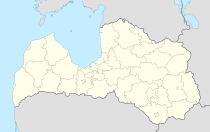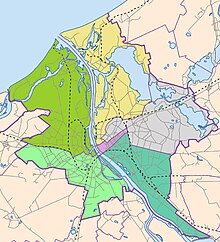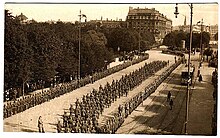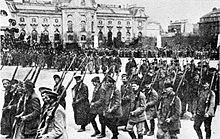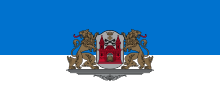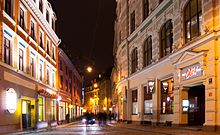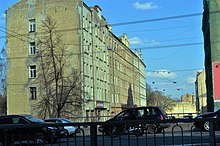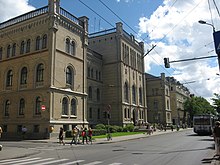Riga
| Rīga ( German : Riga) | ||
|---|---|---|
 |
|
|
| Basic data | ||
| State : |
|
|
| Landscape: | Livonia ( Latvian : Vidzeme ) | |
| Administrative district : | Republic-city of Riga | |
| Coordinates : | 56 ° 57 ′ N , 24 ° 6 ′ E | |
| Residents : | 696,681 (Jul. 1, 2018) | |
| Area : | 307.17 km² | |
| Population density : | 2,268 inhabitants per km² | |
| Height : | 7 m | |
| City law: | since 1225 | |
| Website: | www.riga.lv | |
| Post Code: | 1001-1084 | |
| ISO code: | LV-RIX | |
| View over the old town of Riga | ||
|
Panoramic view over the Daugava to the old town of Riga: The three protruding towers belong (from the right) to the Petrikirche, the cathedral and the Jakobus-Kirche. |
||
Riga ( Latvian Rīga ) is the capital of Latvia and, with around 700,000 inhabitants, the largest city in the Baltic States . With around one million inhabitants in the agglomeration , Riga is also the largest metropolitan area in the three Baltic states. Riga is the country's political, economic and cultural center. The old Hanseatic city is famous for its Art Nouveau buildings and its spacious layout as well as for the well-preserved city center, including the old town in particular. In 2016, Riga was awarded the honorary title of “ Reformation City of Europe ” by the Community of Evangelical Churches in Europe .
geography
location
The old town of Riga is located on the lower reaches of the Daugava ( Latvian Daugava ), the northern suburban counties are already on the Gulf of Riga . The hinterland in the south and west of the city is relatively sparsely populated, extensive moors and swamps once formed a natural protection here. The landscape around Riga, which was shaped by the last Ice Age, has a large number of small lakes and streams, to the east and north of the old town there was still an extensive wasteland of sand dunes in the late 19th century .
climate
The climate is humid continental with warm, humid summers and snowy winters. Temperatures down to −20 ° C are not uncommon.
| Riga | ||||||||||||||||||||||||||||||||||||||||||||||||
|---|---|---|---|---|---|---|---|---|---|---|---|---|---|---|---|---|---|---|---|---|---|---|---|---|---|---|---|---|---|---|---|---|---|---|---|---|---|---|---|---|---|---|---|---|---|---|---|---|
| Climate diagram | ||||||||||||||||||||||||||||||||||||||||||||||||
| ||||||||||||||||||||||||||||||||||||||||||||||||
|
Average monthly temperatures and rainfall for Riga
Source: wetterkontor.de
|
|||||||||||||||||||||||||||||||||||||||||||||||||||||||||||||||||||||||||||||||||||||||||||||||||||||||||||||||||||||||||||||||||||||||||||||||||||||||||||||||||||||
City structure
Riga is divided into three urban districts ( rajons ) and three suburbs ( priekšpilsētas ) with numerous districts (as of January 1, 2010):
-
Centra rajons , 3 km², 24,547 inhabitants
Districts: Centrs (new town), Vecpilsēta (old town) -
Kurzemes rajons , 79 km², 133,505 inhabitants
Districts: Āgenskalns , Bolderāja , Daugavgrīva , Dzirciems , Iļģuciems , Imanta , Kleisti , Ķīpsala , Rītabuļļi , Spilve , Voleri , Zasulauks -
Ziemeļu rajons , 77 km², 80,652 inhabitants
Districts: Čiekurkalns , Jaunciems , Kundziņsala , Mangaļsala , Mežaparks , Mīlgrāvis , Pētersala-Andrejsala , Sarkandaugava , Trīsciems , Vecāķi , Vecdaugava , Vecmīlgrāvis -
Latgales priekšpilsēta , 50 km², 193,287 inhabitants
Districts: Avotu iela , Dārzciems , Dārziņi , Grīziņkalns , Ķengarags , Maskavas forštate , Pļavnieki , Rumbula , Šķirotava -
Vidzemes priekšpilsēta , 57 km², 172,064 inhabitants
Districts: Berģi , Brasa , Brekši , Bukulti , Dreiliņi , Jugla , Mežciems , Purvciems , Skanste , Suži , Teika -
Zemgales priekšpilsēta , km² 41 105 090 inhabitants
Districts: Āgenskalns , Atgazene , Beberbeki , Bieriņi , Bišumuiža , Katlakalns , Mūkupurvs , Pleskodāle , Salas , Šampēteris , Torņakalns , Ziepniekkalns , Zolitude
Land use
- Inhabited area: 67.00 km² (21.8%)
- Commercial area: 52.45 km² (17.0%)
- Roads and paths: 24.64 km² (8.0%)
- Parks: 57.54 km² (19.0%)
- Body of water: 48.50 km² (15.8%)
- Also a lot of forest
neighborhood
The urban area of Riga borders in the northwest on the Baltic Sea, in the northeast and east on the administrative districts ( novads ) Carnikava , Garkalne and Stopiņi , in the south on Salaspils , Ķekava and Olaine and in the west on Mārupe , Babīte and the city of Jūrmala .
history
founding
After 1150 came Gotland merchants regularly to trading on the lower reaches of the Daugava ( Latvian Daugava ) on the river Rīdzene (German: Riege, hence the name Rīga), which culminated here in the Dvina and was filled in later. Its location can only be traced today based on the course of certain streets. Several mission attempts were made from the later founding place of Riga, but they failed until the city was founded. Especially in the last quarter of the 12th century, increasing numbers of German merchants came to Livonia. Initially, the Zemgall port on the lower reaches of the Aa ( Lielupe in Latvian ), around 50 km west of Riga, was an important trading center. At the instigation of German merchants, who received a corresponding papal letter, it was closed in 1200 in order to establish Riga as the only trading center. The city of Riga, founded in 1201 by Bishop Albert von Buxhoeveden from Bremen, became the capital of Livonia (Latin: Livonia). Riga was primarily the seat of the Archbishops of Riga , but it was also an increasingly important trading city that belonged to the Hanseatic League . Especially in the first decades of its existence, Riga grew at a remarkable rate, so that the built-up area had grown by five to six times in less than 30 years. From 1211, the town's citizens, especially the merchants who settled after the subjugation of the surrounding peoples, gained influence; In 1225 the citizens could choose their city vogt (previously appointed by the bishop) themselves. The Riga Council is mentioned for the first time in 1225 and has probably existed since 1222 or 1223. Initially, the Visby city law applied in Riga , then the Hamburg city law, which is based on the Luebian law .
Riga under the Teutonic Order
As part of the eastern colonization , the bishops tried to settle mainly Germans in pagan territory. Militarily they were supported primarily by orders of knights, initially by the Order of the Brothers of the Sword and, after its decline, by the Teutonic Order , into which the Order of the Brothers of the Sword was incorporated. Especially after the expulsion of the crusaders from Palestine, the Teutonic Order began to take care of the Eastern European areas, especially Prussia , but also Livonia . The Teutonic Order was an organizationally independent, powerful ecclesiastical organization that soon competed with the Archbishops of Riga as a new power factor. The Livonian branch of the Teutonic Order was headed by a Landmeister who was directly subordinate to the Grand Master (highest order lord).
The numerous disputes between the Archbishops of Riga and the Teutonic Order were fought out both by force of arms and by trials before the Pope. The archbishops tried to find protection with nearby states (e.g. Denmark), but also with the German emperor. After the Battle of Neuermühlen won by the Order on March 30, 1491, the Teutonic Order and the Archbishop of Riga concluded the Peace of Wolmar . The archbishop recognized the Teutonic Order as the protective power of Livonia and also took part in the Battle of Smolina Lake in 1502 with his own army contingent .
From the Reformation to the Russian provinces
In 1522, Riga joined the Reformation and the power of the archbishops came to an end. The last archbishop of Riga was Wilhelm von Brandenburg . After the outbreak of the Livonian War in 1558 and the dissolution of the Livonian Confederation in 1561/62, the city did not immediately follow the decision of the Archbishop and the Order to submit to Poland-Lithuania , but favored a status as a free imperial city of the Holy Roman, especially in the 1570s Reichs . Only when his hoped-for help failed to materialize, renewed Russian marches led the city to pay homage to Poland's King Stephan Báthory in 1581 , who in return confirmed the city's traditional freedoms and privileges through the Corpus Privilegiorum Stephaneum (sometimes also referred to as Corpus Privilegiorum Stephanorum ). In 1587 Nicolas Mollyn founded the first printing company in Riga. In the following 38 years he published 165 books, 119 of them in Latin, 43 in German and three in Latvian.
The 40-year Polish-Lithuanian rule, under which the citizens resisted counter-Reformation efforts - for example during the calendar unrest - ended with the conquest by Gustav II Adolf in 1621. Sweden's crown treated Riga as the second largest city in the Swedish empire next to Stockholm and, given the strategic importance it played in the defense of the Swedish Dominium maris baltici , had it rebuilt at great expense. During the Russo-Swedish War (1656–1658) , Riga withstood a Russian siege and remained the second largest city under Swedish rule until the beginning of the 18th century. During this time the city enjoyed extensive self-government.
During the Great Northern War , Riga and the Rigans were hit hard several times: by the contributions paid by the city and the citizens and by the fact that Riga became a theater of war. In the battle of the Düna on July 19, 1701, King Charles XII fought back . from Sweden the attack of the Saxon-Russian troops on Riga. On July 4, 1710, after a long siege , the city surrendered to the troops of the Russian general Boris Petrovich Sheremetev . The rise of Russia as a great power in the Baltic Sea region was sealed by the Peace of Nystad in 1721. Riga was added to the tsarist empire.
Livonia Governorate
Riga became the seat of administration and the capital of the Livonia Governorate (see Baltic Governments ). The governor had a “Russian chancellery” for correspondence in Russian with the military authorities and a “German chancellery” for correspondence in German with the state authorities and with the College of Liv and Estonian affairs of the Russian government in Saint Petersburg.
In 1787 a new city constitution was introduced, which overcame the limitation of power to the traditional three “estates” (magistrate, large guild and small guild ) and opened up a say for broader circles of the citizenry. For this purpose, the citizenship was divided into six "classes":
- "Possessive" (i.e. house and land-owning) residents,
- Merchants (divided into three guilds),
- Craftsman,
- Strangers and "guests" (especially traders) from other cities,
- "Well-known" citizens (i.e. those accepted into the citizenship based on their "name" or reputation),
- Sit down .
In 1800 Riga had around 30,000 inhabitants, including 47% Germans, 25% Latvians and 14% Russians. When Napoleon invaded Russia in 1812 , part of the Grande Armée moved into Courland. In response to the - false - rumor that the enemy was marching on Riga, the city commander, Lieutenant General Magnus Gustav von Essen , set fire to the suburbs on the night of July 11th to 12th in order to get a clear field of fire and the enemy no cover to offer. Three churches and more than 700 houses burned down.
By the end of the 19th century, Riga gradually developed into one of the most important ports in Russia. Numerous factories and working-class quarters emerged. The city's population increased tenfold between 1850 and 1900. According to the 1881 census, around 60% of the immigrants came from the Baltic Sea Governments of Livonia and Courland , 27% came from Latgale ( Vitebsk Governorate ), as well as from Lithuania ( Kovno and Vilnius Governments) and other governorates of the Russian Empire , 12% came from Germany. A good 30% of the population stated in 1881 to be Baltic German, around 33% were Latvians, 19% were Russians or Old Believers, 8.5% were Jews. In 1913 around 40% of the population stated to be Latvians, just under 20% Russians and Old Believers, around 13% Baltic Germans , and around 7% of the inhabitants were Jews. In addition, Riga had a significant Polish and Lithuanian minority.
In the second half of the 19th century and until 1918, three-class voting rights applied to the election of the city council . In 1878 the 1st class (citizens with an annual tax contribution of 420 rubles and more) belonged to 173 citizens, the 2nd class (annual tax contribution from 115 to 419 rubles) 629 citizens and the 3rd class (annual tax payments from 16 to 114 rubles) 4410 citizens . A total of 3.4% of the city's residents had the right to vote in 1878. Despite Russian rule, both the urban culture and the large estates were shaped by the influence of the German upper class in the country until the 19th century. Until 1891 the official language was German, then Russian became the official language.
First World War and Latvian War of Independence
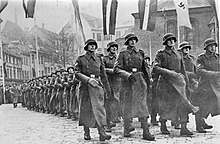
The rise of Riga was suddenly interrupted by the First World War. The city was on the front line from 1915 , and to ensure the war economy, around 200,000 inhabitants (workers with their families) were deported to central Russia for armament purposes. In September 1917, the city was captured by the German army in the battle for Riga .
After the end of the war, an independent Republic of Latvia was proclaimed on November 18, 1918 in what is now the Latvian National Theater in German-occupied Riga. Riga became the capital of Latvia. During the Latvian War of Independence , Riga and / or parts of Riga were captured by various troop units in the course of 1919; three Latvian governments with very different orientations replaced one another:
- In the days from January 2 to 4, 1919, Soviet Russian troops , supported by Red Latvian riflemen , captured Riga. From January 4 to May 21, the Soviet power of the Latvian SSR ruled .
- After the Red Army was expelled from Riga on May 22, 1919 by the Baltic State Armed Forces and the German Freikorps, Andrievs Niedra resided as Prime Minister in a puppet government set up by the Allied authorities, bourgeois Latvians and the German General Command . After the armistice of Strasdenhof on July 3, the Freikorps withdrew; the Niedra government resigned.
- Kārlis Ulmani's parliamentary government returned to Riga on July 7th as a result of the Strasdenhof armistice. In the days from October 8-10 , 1919, the Bermondt Army captured the districts to the left of the Daugava. In Riga, there were only comparatively weak Latvian units, as most of the Latvian troops were tied up in the fight against the Soviet army to liberate Latgale. Nevertheless, thanks to the support of Estonian troops in Riga, the Latvian troops were able to hold the right bank of the Daugava. On November 11th, they also succeeded in retaking the western suburbs of Riga. The name of the boulevard between the old town and Daugava is reminiscent of this : 11th novembra krastmala (11th November Embankment ).
The sphere of influence of the respective Rigan government, that is, the extent of the area in which it actually had the say, changed constantly as a result of the war. On August 11, 1920, the Republic of Latvia and the Russian Soviet Federative Socialist Republic signed the Treaty of Riga , which ended the War of Independence. On March 18, 1921, the Polish-Soviet peace treaty was signed in Riga .
Interwar period
The war years from 1914 to 1920 (First World War and Latvian War of Independence ) were followed by a renewed heyday in Riga's history. Riga was the capital of independent Latvia and the seat of the Saeima , the Latvian parliament. In addition to the Latvian majority, there were large minorities in the city: Russians, Germans, Jews and others. As early as December 1919, the Latvian People's Council had legally guaranteed the minorities extensive rights, including a. own schools and their self-administration. The Herder Institute existed from 1920 to 1939.
In 1938 Riga had around 385,000 inhabitants, around 45,000 of whom were of German descent.
Second World War
With the takeover of the National Socialists in Germany, Latvia was threatened not only by the newly emerging hegemonic tendencies of the Soviet Union, which called for annexation of the formerly belonging to the Russian Empire territory. In the Hitler-Stalin Pact of August 1939, the two dictatorships agreed that the Baltic States, and thus Latvia, would come under the Soviet sphere of influence. In autumn 1939 the Baltic Germans were resettled in accordance with the agreement in the Warthegau , which had been conquered by the German Reich . This was an area of Poland annexed by Germany in violation of international law. On June 17, 1940, Soviet tanks rolled through Riga's streets and occupied the city. The Soviet Union made Latvia a Soviet Republic ( Latvian Soviet Socialist Republic ) and deported many Latvians, especially those from the educated and property classes and the political elite, to the interior of the Soviet Union.
In the course of the attack on the Soviet Union (from June 22, 1941), German troops captured the districts to the left of the Daugava (Pārdaugava) on June 29 and the remaining districts in the following two days. During the German occupation from 1941 to 1944, Riga was the administrative seat of the General Commissioner for the General District of Latvia, Otto-Heinrich Drechsler . The Reichskommissariat Ostland , which was initially set up in Kaunas , was also located here with its offices.
The Jewish population, around 44,000 in 1933, was interned in the Riga ghetto from July 1941 . There were also deported Jews on trains from the Reich territory (Berlin, Hanover, Cologne and Vienna) and from German-occupied Czechoslovakia (from the Theresienstadt concentration camp ). There were later prisoners in the Salaspils labor and education camp , the Riga prisoner-of-war main camp 350 and its branch camp Stalag 350 / Z , the Riga-Kaiserwald concentration camp , in the former villa suburb of Mežaparks- Kaiserwald and its satellite camps and the Jungfernhof concentration camp in the village of Jumpravmuiza, close by the Skirotava train station . From 1941 to 1944, around 20,000 Jews, 10,000 prisoners of war and 5,000 resistance fighters were murdered in numerous massacres in the Biķernieki forest . From November 30 to December 9, 1941, around 27,500 Jews were murdered in the Rumbula forest .
Riga's old town was badly damaged during the armed conflict to recapture the city by the Red Army (October 13-15, 1944). Latvia was again occupied by the Soviet Union and Riga the capital of the Latvian Soviet Socialist Republic.
In Riga there were three Soviet POW camps 277, 317 and 350 for German POWs from World War II . Seriously ill people were cared for in prisoner-of-war hospitals 3338 and 4379 .
Restoration of independence
Encouraged by perestroika and glasnost , the Supreme Soviet of the Latvian Soviet Socialist Republic (which constituted itself as Saeima , the Latvian parliament) declared the restoration of independence from the Soviet Union in 1990. The then General Secretary of the Central Committee of the CPSU and President of the Soviet Union, Mikhail Gorbachev , had the parliament building in Riga temporarily occupied by Soviet military units. On August 21, 1991 the Soviet Union recognized the independence of Latvia; likewise (after the collapse of the Soviet Union ) in 1991 the Russian President Boris Yeltsin . Riga again became the capital of a sovereign Latvian state.
population
The two largest population groups in the city are Latvians and Russians: According to the 2011 census, Latvians make up 46.3% of the city's population. You are a narrow relative majority. 40.2% are Russians , 3.8% Belarusians , 3.4% Ukrainians , 1.8% Poles and 4.5% members of other ethnic groups . In a national referendum in February 2012, the introduction of Russian as the second official language was rejected by 74.8% of voters.
Population development
With 696,681 inhabitants (as of July 1, 2018), Riga is the most populous city in the Baltic States ; however, the number of inhabitants has fallen sharply since 1990 and continues to fall. There are three reasons:
- the migration of young families in particular to the surrounding communities, especially to Mārupe , Jaunmārupe , Salaspils , Ķekava and Olaine , where building land is affordable
- the relocation of members of all ethnic groups to Western Europe (in contrast, the return of Russians to Russia is hardly significant.)
- the extremely low birth rate : Already in the Latvian Soviet Socialist Republic was one whose birth rate among the lowest of all the Union republics .
|
|
|
|
|

languages
For the years from 1867 to 1930, the composition of the Riga residents according to their mother tongue or colloquial language is shown in the table below:
| language | 1867 | 1881 | 1897 | 1913 | 1930 |
|---|---|---|---|---|---|
| German | 43,980 (42.9%) | 66,775 (39.4%) | 65,332 (25.5%) | 78,656 (16.7%) | 44,105 (11.67%) |
| Latvian | 24,199 (23.6%) | 49,974 (29.5%) | 106,541 (41.6%) | 187,135 (39.6%) | 227,842 (60.29%) |
| Russian | 25,772 (25.1%) | 31,976 (18.9%) | 43,338 (16.9%) | 99,985 (21.2%) | 29,696 ( 7.86%) |
| Yiddish | 5,254 ( 5.1%) | 14,222 ( 8.4%) | 16,521 ( 6.5%) | 21,231 ( 4.5%) | 42,328 (11.20%) |
| Estonian | 872 ( 0.9%) | 1,565 ( 0.9%) | 3,532 ( 1.4%) | 6,721 ( 1.4%) | 2,443 ( 0.65%) |
| Polish | ... | ... | 12,869 ( 5.0%) | 35,621 ( 7.5%) | 16,574 ( 4.39%) |
| Lithuanian | ... | ... | 5,853 ( 2.3%) | 25,824 ( 5.5%) | 6,817 ( 1.80%) |
| Other * | 2,513 ( 2.4%) | 4,048 ( 2.4%) | 1,772 ( 0.7%) | 16,895 ( 3.6%) | 8,112 ( 2.14%) |
| without specification | ... | 769 ( 0.5%) | 130 ( 0.1%) | ... | ... |
| total | 102,590 (100%) | 169,329 (100%) | 255,879 (100%) | 472,068 (100%) | 377,917 (100%) |
* The figure for 1881 also includes the Polish and Lithuanian-speaking residents
Politics and administration

The city is the seat of the President , the Parliament ( Saeima ), the ministries, the Supreme Court ( Latvijas Republikas Augstākā tiesa ) and numerous diplomatic missions.
The city administration has its seat in the town hall on Rathausplatz (Ratslaukums) in the old town. The city council has 60 members who are elected every four years and elect the council chairman and thus the mayor from among their ranks. In 2009, Nils Ušakovs was the first ethnic Russian to be elected mayor of Riga in independent Latvia. The council presidium consists of members from all council groups and the mayor. Public meetings usually take place once a month.
Symbols
coat of arms
| Blazon : "The Riga coat of arms shows in the resolution adopted on October 31, 1925 form on a silver plate , a wall with two outer towers of red stones and [heraldic] open gate with open gate , is a golden lion's head , between the towers two crossed , black Key , above it a floating golden cross , above it a golden crown . The shield is framed by two golden, red-tongued lions with their heads turned away from the shield, standing on a gray console that is held up by stylized foliage . " | |
| Justification of the coat of arms: the wall and towers symbolize the city's rights , the lion the defensibility of the city, the keys the patronage of Peter , the cross the Teutonic Order . A golden crown, which represents the crown of the Swedish king , hovers over the keys of Peter . |
flag
The flag from 1937 shows the coat of arms in the middle on two horizontal, light blue and white stripes.
Twin cities
Riga's first partnership was concluded in 1964 with the Finnish city of Pori, which was followed in 1973 by a partnership with Calais in France, which was characterized by a lively exchange until 1993. The Japanese Kobe has been the first non-European twin city since 1973. With Rostock (1974) and Bremen (1985) two former German Hanseatic cities became partners of Riga. The partnership agreements with both cities were renewed in 1991.
|
|
|
|
|
|
|
|
|
|
|
|
|
|
|
|
|
|
|
|
|
|
|
|
|
|
|
|
|
|
|
|
|
|
|
|
|
|
|
|
|
|
|
Cityscape and architecture
The city center of Riga was added to the list of UNESCO World Heritage Sites in 1997 because of its "exceptional universal value" due to the globally unique quality and quantity of Art Nouveau architecture with the historical urban structure remaining relatively intact and the wooden architecture from the 19th century.
Due to the plans for further urban development on the left Dunes, especially the island of Ķīpsala, there is a risk that Riga will be placed on the Red List of World Heritage in Danger . Specifically, the experts from UNESCO and ICOMOS see the construction of high-rise buildings as endangering the visual integrity of the cityscape. The city administration was asked to revise the plans. It is widely recognized that the administration, management and conservation of the World Heritage site is improving.
The urban pattern of Riga includes the medieval core, a semicircle of boulevards around the old town and the new town with its regularly laid out streets. All areas were able to retain their authenticity and architectural character.
View of the city from the tower of the Petrikirche (May 2016)
Churches
Old town
The old town ( Latvian Vecrīga ) is the historical and geographical center of Riga on the right bank of the Daugava and was able to retain its fortress character between 1857 and 1863 despite the demolition of the fortifications and walls. The open spaces created after the demolition of the Riga city wall were transformed into a city park with the city canal ( Pilsētas kanāls ), which today separates the old town from the new town.
The center of the old town is the market square (today Rātslaukums ), where the Riga City Hall ( Rīgas rātsnams ) and the House of the Blackheads ( Melngalvju nams ) are located. The latter was rebuilt in 1999 after it was destroyed in the war and the ruins were then blown up by the Soviets. The original Gothic building with the facade in the style of the Dutch Renaissance was built in 1334 and served as a meeting place for the merchant association of Blackheads from 1477 . There is a statue of Roland in the square in front of the building .
The foundation stone of the cathedral ( Rīgas Doms ) was laid in 1211 by Bishop Albert von Buxthoeven . The side aisles were added in the 14th and 15th centuries. After being destroyed several times, the height of the tower has been 90 meters since 1776, the height of the wooden tower built around 1590 was 140 meters. The organ, built at the end of the 19th century, is one of the largest and best organs in the world. The towers of the Petri Church ( Rīgas Svētā Pētera baznīca ), first mentioned in 1209 , were destroyed several times, most recently in World War II. The Jacob's Church ( Rīgas Svētā Jēkaba katedrāle ), first mentioned in 1225, with its 80-meter-high tower is Riga's Catholic cathedral. It was bought by the Polish king in 1582 and given to the Jesuits.
The Riga Castle ( Rīgas pils ) is the official residence of the President . It was built from 1330 as a fortress of the Brothers of the Sword .
The Saeima , Latvia's parliament , has been located in a building built in the style of a Florentine palace in 1867 . With the Powder Tower ( Pulvertornis ) from 1650, a remnant of the former city fortifications still exists. Other historical monuments are the Riga Stock Exchange building created in 1852, the Konventhof ( Konventa sēta ) with origins in the 13th century, the Three Brothers ' building complex built between the 15th and 17th centuries , the Swedes Gate ( Zviedru vārti ), the buildings of the Small ( Mazā Ģilde ) and large guild ( Lielā Ģilde ), the Mentzendorff house ( Mencendorfa nams ) from 1695 or the Dannensterna nams ( Dannenšterna nams ).
The Freedom Monument ( Brīvības piemineklis ), created by Kārlis Zāle , has been located between the old and new towns since 1935 with a female allegory of freedom on the 19-meter-high obelisk and bas-reliefs on the sides depicting historical events.
New Town and Suburbs
In Neustadt there are numerous buildings with Art Nouveau facades , especially in Elisabethstraße ( Elizabetes iela ) and Albertstraße ( Alberta iela ) with many works by Michail Eisenstein . At the turn of the century, numerous representative buildings were erected in the green belt around the old town, including the National Opera, the National Theater, the Art Museum, the neo-Gothic Latvian Art Academy ( Latvijas Mākslas akadēmija ) from 1905 and the university. The Orthodox Cathedral ( Rīgas Kristus Piedzimšanas pareizticīgo katedrāle ) was built between 1876 and 1884 in the Neo- Byzantine style.
In the southern district of Moscow suburb (maskavas forštate) are the former Zeppelin halls of the Central Market ( Rīgas Centrāltirgus ), the Red memory , in Stalinist the gingerbread style built in 1958 Culture and Science Palace ( Zinātņu Akadēmijas augstceltne ) consisting of wood in the classical style built Protestant Church of Jesus ( Jēzus Evaņģēliski luteriskā baznīca ) and the ruins of the synagogue near the former Riga ghetto .
The garden city Mežaparks is a villa suburb that was built in the woods north of the city at the beginning of the 20th century.
The Riga television tower ( Rīgas radio un televīzijas tornis ) is located on the Daugava island of Hasenholm ( Zaķusala ). At 368.5 meters, it is one of the tallest structures in Europe and its slim construction (with the three-legged foundation) makes it a very slim one Fits tower of Petrikirche. Pārdaugava (German Überdüna) refers to the urban area on the left Dunes. For a long time it was characterized by one to two-story wooden houses, some of which have been preserved.
Parks
In the city center there is the Wöhrmannsche Garten ( Vērmanes dārzs ), the oldest public park in the city, which was created in 1814 under the name Anna-Wöhrmann-Park. Before that, there had been wooden houses in its place, which had been set on fire as a precautionary measure before Napoleon's feared city siege. Along the moat at the former city fortifications ( Pilsētas kanāls ) there is an approximately three kilometer long park ( Kanālmalas apstādījumi ) - the Basteiberg . Across from the Art Nouveau quarter is the Kronwald Park ( Kronvalda parks ) - it was created on the former site that was given to the German Rifle Club by Tsar Alexander II. The Esplanade ( Esplanāde ) is located by the Orthodox Cathedral and includes a market in the northern part.
With an area of 37 hectares, Uzvaras Park is the largest in the city. It houses the 79 meter high Soviet Victory Column from 1985.
The Riga Zoo ( Rīgas Zooloģiskais dārzs ) contains over 3000 animals. There are several forest cemeteries in Mežaparks, including the Brothers Cemetery , a military cemetery that has the character of a park.
Economy and Infrastructure
economy
The Riga region is the economically strongest region and the center of industrial production in the country. 60% of Latvian companies operate in Riga, and more than 50% of the employees are active in the region. The food industry in particular, but also the wood, textile, chemical and pharmaceutical industries are important. Riga is increasingly attracting foreign investment and is becoming an important location for commercial exhibitions in the Baltic region.
Almost all of the largest companies of Latvia are located in Riga, including the specialized IT products wholesaler ELKO Grupa , the retail chain Rimi Latvia , the national power utility Latvenergo , the natural gas monopolist Latvijas Gāze , the railway company Latvijas Dzelzcels , the state postal company Latvijas Pasts and Latvia Statoil , the offshoot of the Norwegian oil company, as well as Mazeiku Nafta tirdzniecibas nams , the mobile operator Latvijas Mobilais Telefons (LMT) and the airline air Baltic . The Riga Stock Exchange (NASDAQ OMX Riga) is the country's only stock exchange . The central market in Riga is well known and used a lot . There is also a night market in the city .
The tourism is to choose an important economic factor for the city, 90% of tourists in the country Riga as a destination.
traffic
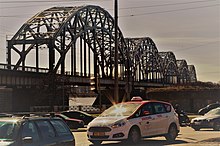
Riga has an important function as an international transport hub in the Baltic Sea region (traffic flows between Scandinavia and Eastern Europe, from Central Europe to Finland via European route 67 ("Via Baltica") and within the Baltic region ). This is where by far the most important train station in the country, Riga Central Station ( Rīgas dzelzceļa stacija ), has connections to Moscow and St. Petersburg in Russia , Minsk in Belarus and Kaunas and Vilnius in Lithuania . There is also a bus station ( Rīgas Starptautiskā autoosta ) with long-distance bus connections to all neighboring countries and many countries in the European Union .
The Riga Airport ( Starptautiskā lidosta "Rīga" ) is the largest of the Baltic States and offers flights to 82 destinations. Since the capacity of 2.5 million was exceeded with four million passengers in 2009, the expansion is planned. AirBaltic plans to build a new terminal for 92 million euros.
The port of Riga is the most important in the country. In 2016, 59% of Latvian imports and exports were handled by sea in Riga.
A ferry terminal ( Rīgas Pasažieru termināls ) offers connections mainly to Scandinavia, but also to Northern Germany.
Latvia's state roads are oriented in a star shape towards Riga. A new bridge over the Daugava River ( Dienvidu tilts ) was built for a bypass road south of the city center and opened in 2008. The feeder roads were opened to traffic between 2013 and 2016. A 27 to 30 kilometer long motorway is planned as a northern bypass ( Ziemeļu koridors ), which is to be built gradually in four sections. It is the largest infrastructure project in Riga in recent decades.
The urban public transport company Rīgas Satiksme has a system of suburban trains similar to that of the S-Bahn and a very well developed tram network (252 cars, nine lines). The rail network is supplemented by the Riga trolleybus (around 330 cars, 20 lines) and various bus routes (around 460 cars, 53 lines).
Riga is connected to some long-distance cycle routes, including international ones, in particular to the Baltic Sea Cycle Route , which once circles the Baltic Sea, and to the Iron Curtain Trail , the longest official cycle route in Europe along the former Iron Curtain from Norway to the Black Sea.
Due to the long tradition of multilingualism in the city, there are often German-speaking street names for the streets of Riga .
media
Riga is the center of the main media in the country. The public television and radio companies Latvijas Televīzija (LTV) and Latvijas Radio with their numerous programs are also based in Riga, as is the private television broadcaster TV3 Latvia and the Russian-language broadcaster PBK Latvia . With TV5 Rīga is only the city dedicated channel. After independence, private radio stations such as Radio Skonto , European Hit Radio and Radio SWH were established . The daily newspapers are Diena and Latvijas Avīze . The Baltic Times is an English-language weekly newspaper for the three Baltic States based in Riga. With Rīgas Apriņķa Avīze there is a regular regional newspaper for Riga and the surrounding area.
education

The Latvian Academy of Sciences ( Latvijas Zinātņu akadēmija ) has its seat in Riga. It has a nuclear research center in Salaspils, southeast of Riga.
With independence in 1919, the University of Latvia ( Latvijas Universitāte ) was founded, which goes back to the Riga Polytechnic founded in 1862. With around 23,800 students in 13 faculties, it is the largest university in the country. The Riga Technical University ( Rīgas Tehniskā universitāte ) founded in 1958 with 16,900 students can also be traced back to the Polytechnic. The Stradina University of Riga ( Rīgas Stradiņa universitāte ) has also existed since 2002 . It has been operating as the Latvian Medical Academy ( Latvijas Medicīnas akadēmiju ) since 1990 and is based on the medical faculty of the University of Latvia from 1919.
The Riga Graduate School of Law has existed as an independent institution within the University of Latvia since 1998 . The Stockholm School of Commerce in Riga is a subsidiary of the Stockholm institution . There is also a conservatory, numerous other universities of applied sciences and a Goethe Institute .
Culture
In 2014, Riga was the European Capital of Culture . Infrastructural projects in this context include the construction of the Latvian National Library ( Latvijas Nacionālās bibliotēkas ) designed by Gunnar Birkerts on the Dünaufer opposite the old town, a concert hall ( Koncert zale ) as the home of the Latvian National Symphony Orchestra and the establishment of the Museum of Contemporary Art ( Laikmetīgās mākslas muzejs ) in a former power station building in Andrejsala . Despite a budget cut of 30% as a result of the Latvian economic crisis in 2009, the mayor is optimistic that Riga can offer a successful 2014 program.
theatre
The Latvian National Opera ( Latvijas Nacionālā opera ) has been located in the neoclassical building (1860–1863), which was designed as a German theater, since it was first performed in January 1919. The repertoire includes opera classics, and the ballet company, which has existed since 1922, is also known. One of the largest theaters in the country is the Latvian National Theater , which was founded in 1919. From 1837 to 1839 Karl von Holtei was the successful director of what was then a German-speaking theater in Riga, for which he had hired Richard Wagner as conductor. The Riga Russian Theater ( Mihaila Čehova Rīgas Krievu teātris ) is the country's oldest professional drama theater; 1883 was the first season of the theater, whose repertoire includes Russian and foreign plays. Opened in 1920, the Daile Theater ( Dailes teātris ) regularly presents modern foreign plays. The Latvian State Puppet Theater ( Latvijas Valsts Leļļu teātris ), founded in 1944, primarily targets children with its performances . After independence, the New Riga Theater ( Jaunais Rīgas teātris ) was established in 1992 as the successor to the State Theater for Young Audiences of the Latvian Soviet Socialist Republic .
Museums
- Museums on history and cultural history:
- The Latvian Occupation Museum ( Latvijas Okupācijas muzejs ) is located in a building from the 1970s and is dedicated to the time when Latvia was under German and Soviet occupation (1940–1991).
- The City History and Maritime Museum ( Rīgas vēstures un kuģniecības muzejs ) is one of the oldest museums in Europe. Attached to this is the Mentzendorffhaus ( Mencendorfa nams ), which can be visited as a historic residential and commercial building.
- The Museum Jews in Latvia ( Muzejs Ebreji Latvijā ) shows the history of the Jews of Riga and Latvia from the 18th century to 1941.
- The Latvian History Museum ( Latvijas Vēstures muzejs ) in Riga Castle is dedicated to the history of the country from the Stone Age to the present day.
- In 2014, the corner house ( Stura maja ), the former headquarters of the Soviet secret service KGB in occupied Latvia, opened as a museum and memorial.
- The Latvian War Museum ( Latvijas Kara muzejs ) for military and war history is located in the Powder Tower .
- Pauls Stradiņš Museum of Medical History (around 200,000 exhibits)
- The Latvian Open Air Museum on Lake Jugla houses 118 buildings of folk architecture and shows the traditional rural way of life.
- Art museums:
- The Museum of Foreign Art ( Ārzemju mākslas muzejs ) houses the largest collection of European art from the 16th century to the present in Latvia.
- The Latvian National Art Museum ( Latvijas Nacionālais mākslas muzejs ) is dedicated to Latvian art.
- The Museum of Decorative Arts and Design has existed since 1989 and shows works by artists from the period since the end of the 19th century.
There is also a Latvian Natural History Museum ( Latvijas Dabas muzejs ) and a Riga Motor Museum ( Rīgas Motormuzejs ) with historical vehicles.
music
In the 17th century, European music began to flourish in Riga, which developed into the most important music center in the Baltic region at the time. The Riga Music Society was founded (1760) and private orchestras such as that of Baron Otto Hermann von Vietinghoff , from which the orchestra of the opera, founded in 1782, later formed. Among others, Johann Valentin Meder , Johann Gottfried Müthel and Georg Michael Telemann worked in Riga . In the 19th century, two parallel musical traditions existed with German art music and the folkloric songs developed by the Latvians, who were largely without rights. From 1837 to 1839 Richard Wagner worked as Kapellmeister at the opera, which at that time had reached an international level. Leo Blech conducted numerous opera performances from 1938 to 1941 as the first guest conductor of the National Opera.
From 1911 to 1914 Franz von Hoeßlin was the conductor of the Riga Symphony Orchestra. The Latvian State Music Academy Jāzeps Vītols was founded in 1919 as a conservatory and has around 500 students. Classical concerts take place today in the House of the Blackheads and in the Great Guild.
In 1993 the first National Song Festival in independent Latvia took place in Riga ; The tradition of the Baltic song festivals is very old, in Latvia the first took place as early as 1873. In 2003 the singing festivals of all three Baltic states were added to the UNESCO list of “ Masterpieces of the Oral and Intangible Heritage of Humanity ”. The XXIV National Song Festival took place in 2008 in Riga. A special highlight are the “Wars of Songs”, in which the best choirs in the country compete against each other.
In 2003 the Eurovision Song Contest took place in Riga .
Sports
The Arēna Rīga , which can hold a maximum of 14,500 spectators and is used for ice hockey, basketball and concerts, was built for the 2006 Ice Hockey World Championship . It serves as the home venue of the Dinamo Riga club, which plays in the Russian KHL . The most successful football club in the country with 14 championship titles is Skonto Riga with the Skonto Stadium ( Skonto stadions ) which opened in 2000 and holds 10,000 spectators . Other first division clubs are JFK Olimps Riga ( Daugava Stadium / Daugavas stadions ) and FK Jaunība Riga . With 18 titles won in the FIBA EuroLeague Women , TTT Rīga is one of the most successful clubs in European women's basketball. The successful men's basketball club are the BK Barons / LMT (Latvian champions 2008) and VEF Riga . The Skonto Arena (6500 spectators) was opened in 1999 and is used by the Skonto Riga basketball team. The internationally successful ice hockey club HK Riga 2000 existed until 2009 and played in the inbox.lv ledus hall .
Regular events
The Riga Marathon ( Rīgas maratons ) has been held annually since 1991 . In 1998, the Riga Summer Opera Festival ( Rīgas Operas festivāls ) was organized for the first time .
- Ballet festival
- Baltic Spring theater festival
Culinary specialties
A Riga specialty is the bitter, black liquor Rīgas Melnais balzams , which is considered the Latvian national drink. Riga is also known for chocolate and pralines.
sons and daughters of the town
People who worked in Riga
- Bernhard Bielenstein (1877–1959), Art Nouveau architect
- Rupert Bindenschu (1645–1698), architect and city builder in Riga
- Heinrich Julius Böthführ (1811–1888), mayor
- Georg Ludwig Collins (1763–1814), Protestant clergyman
- Carl Diercke (1842–1913), cartographer, was a teacher in Riga from 1865 to 1869
- Michail Eisenstein (1867–1920), civil engineer and Art Nouveau architect
- Heinz Erhardt (1909–1979), German comedian, musician, composer, actor and poet
- Alexander Faltin (1819–1899), German Riga councilor, founder of the Baltic Monthly, initiator of the Riga-Daugavpils Railway
- Paul Albert Glaeser-Wilken (1874–1942), director and actor, worked from 1912 to 1914 at the Riga City Theater
- Karl Ludwig Grave (1784–1840), clergyman and educator
- Teodors Grīnbergs (1870–1962), theologian
- Oskar Grosberg (1862–1941), German-Baltic journalist and writer, from 1916 to 1939 editor of the Rigaschen Rundschau
- Karl August von Hardenberg (1750–1822), Prussian statesman, wrote the Riga memorandum in exile in Riga in 1807, which pioneered the reform of the Prussian state
- Johann Gottfried Herder (1744–1803), German poet, was a collaborator and parish junior in Riga from 1764 to 1769
- Karl von Holtei (1798–1880), German writer, actor and theater director, director of the theater in Riga from 1837 to 1841
- Carl Gustav Jochmann (1789–1830), German publicist
- Conradin Kreutzer (1780–1849), German composer, died in Riga in 1849
- Ludwig August Mellin (1754–1835), Baltic German politician, cartographer, director of the Livonian Upper Consistory
- Johann Gottfried Müthel (1728–1788), German harpsichordist, organist and composer, active in Riga since 1753, since 1767 as main organist at the St. Petri Cathedral there, died in 1788 in Riga
- Kristīne Opolais (* 1979), soprano at the Latvian National Opera from 2001 to 2007
- Bernhard Press (1917–2001), born in Riga, trained and active pathologist, university professor
- Louise Radecke (1846–1916), opera singer
- Thomas von Ramm († 1631), Mayor of Riga
- Johann Schöning , Mayor and Archvogt (second half of the 15th century)
- Johann Christoph Schwartz (1722–1804), Mayor of Riga (1782–1787)
- Martin Sihle (1863–1945), director of the I. Med. University Clinic in Riga
- Karl Gottlob Sonntag (1765–1827), German clergyman, senior pastor in Riga and general superintendent of Livonia
- Pēteris Vasks (* 1946), Latvian composer, lives in Riga
- Richard Wagner (1813–1883), German composer, lived in Riga from 1837 to 1839
literature
- Back memories of a trip through part of Germany, Prussia, Courland and Liefland, during the stay of the French in Mainz and the unrest in Poland. Nicolovius, Strasburg / Königsberg 1795 ( digitized at archive.org; data sheet of the digitized version of the Tartu University Library for PDF; 89.4 MB ).
- Andris Kolbergs: Portrait of a City. History of Riga's old town. Translated from Latvian by Anita Muitniece. Jāņa Sēta Publishing House , Riga 1998, ISBN 9984-07-113-8 .
- Andreas Fülberth: Riga. Little history of the city. Böhlau, Cologne / Weimar / Vienna 2014, ISBN 978-3-412-22165-2 .
- Michael Garleff : Riga / Rīga . In: Online encyclopedia on the culture and history of Germans in Eastern Europe , Oldenburg 2012.
Bibliographies
Monographs
- Andrej Angrick , Peter Klein: The “Final Solution” in Riga. Exploitation and destruction 1941–1943 (= publications by the Ludwigsburg Research Center of the University of Stuttgart. Volume 6). Scientific Book Society, Darmstadt 2006, ISBN 3-534-19149-8 (complete presentation).
- Friedrich Benninghoven : Rigas origin and the early Hanseatic merchant (= North and East European history studies. Volume 3). Velmede, Hamburg 1961, DNB 450356868 .
- Skaidrīte Cielava, Zenta Ērgle: What Altriga's streets and houses tell. German Version by J. Bernšteins. Verlag Liesma, Riga 1977, DNB 790447169 (Latvian: Par ko stāsta vecās Rīgas ielas un nami ).
- Ulrike von Hirschhausen : The limits of commonality. Germans, Latvians, Russians and Jews in Riga 1860–1914 (= critical studies on historical science . Volume 172). Vandenhoeck & Ruprecht, Göttingen 2006, ISBN 3-525-35153-4 (Zugl .: Göttingen, Univ., Habil.-Schr., 2005).
- Wilhelm Lenz : Riga between the Roman Empire and Poland-Lithuania in the years 1558–1582 (= scientific contributions to the history and regional studies of East Central Europe. Volume 82). Herder Institute publishing house, Marburg 1968.
- Ilgvars Misāns , Horst Wernicke (Hrsg.): Riga and the Baltic region. From the foundation in 1201 up to the early modern period (= conferences on East Central Europe research. Volume 22). Herder Institute, Marburg 2005, ISBN 3-87969-319-6 (contributions partly in German, partly in English).
- Erwin Oberländer , Kristine Wohlfart (Ed.): Riga. Portrait of a multiethnic city on the edge of the tsarist empire 1857–1914. Schöningh Verlag, Paderborn u. a. 2004, ISBN 3-506-71738-3 .
- Andreas Fülberth: Tallinn - Riga - Kaunas. Their expansion into modern capitals 1920–1940 (= The Baltic States in the past and present. Volume 2). Böhlau, Cologne / Weimar / Vienna 2005, ISBN 3-412-12004-9 (Zugl .: Münster [Westphalia], Univ., Diss., 2001).
Documentaries
- Pictures of a landscape: Riga - Rose in the Baltic States. Documentation, about 45 minutes, production: BR , 2003.
- Treasures of the world - legacies of humanity. Episode 149: Riga - Hanseatic League, Amber, Art Nouveau (Latvia). Documentation, about 15 minutes, production: SWR , 2004 ( series index PDF; 601 kB ), accessed on November 24, 2016.
Web links
- Riga city website. In: riga.lv. (Latvian, Russian).
- Illustration of the city in 1550 in Civitates orbis terrarum ( Memento of July 11, 2009 in the Internet Archive ) by Georg Braun
Individual evidence
- ↑ City portrait of the project “Reformation Cities of Europe”: Reformation City Riga. Latvia. The new teaching came over the Baltic Sea. In: reformation-cities.org/cities. Community of Protestant Churches in Europe, accessed on October 8, 2017. On the importance of Riga in the history of the Reformation, see the section From the Reformation to the Russian Province and the city portrait of the project “European Station Path” : Riga. In: r2017.org/europaeischer-stationsweg, accessed on November 23, 2016.
- ↑ Data on population development: Latvijas iedzivotaju skaits pašvaldibas ( Memento from August 11, 2011 in the Internet Archive ) (PDF; 59 kB). In: gov.lv. Pilsonības un migrācijas lietu pārvalde, accessed November 24, 2016.
- ↑ Rīgas pašvaldības portāls ( Memento of February 28, 2009 in the Internet Archive ). In riga.lv. 2003, accessed November 24, 2016.
- ^ Richard Hausmann : The Recess and other acts of the Hanseatic Days from 1256 to 1430. In: Baltic monthly . Volume 20, issue January – February 1871, pp. 86–99, here: p. 94.
- ^ Wilhelm Ebel : Lübisches law in the Baltic Sea area. Westdeutscher Verlag, Cologne / Opladen 1967, p. 17.
- ↑ Anna Ziemlewska: Riga and the Roman Empire after the dissolution of the Livonian Confederation . In: Thomas Lau, Helge Wittmann (ed.): Emperor, Empire and Imperial City in Interaction . Michael Imhof Verlag, Petersberg 2016, ISBN 978-3-7319-0262-1 , pp. 147–156.
- ↑ Heinz von zur Mühlen : The East Baltic under the rule and influence of the neighboring powers (1561-1710 / 1795) . In: Gert von Pistohlkors (ed.): German history in Eastern Europe. Baltic countries . Siedler, Berlin 1994, ISBN 3-88680-214-0 , pp. 173–264, here p. 182.
- ^ Arveds Schwabe: Histoire du peuple letton. Bureau d'Information de la Légation de Lettonie à Londres, Stockholm 1953, p. 120.
- ↑ Chorographic delineation of the Glükligen Descente over the Daugava, sambt the Victorieusen Bataille of His Royal Mayestet from South Carl XII. (Contemporary illustration of the passage of the Swedish troops over the Daugava with a detailed map of the area around Riga).
- ↑ Riga . In: Meyers Großes Konversations-Lexikon . 6th edition. Volume 16, Bibliographisches Institut, Leipzig / Vienna 1908, pp. 931–933 . - Accessed November 24, 2016.
- ↑ Reinhard Wittram : Baltic history. The Baltic countries of Livonia, Estonia, Courland 1180–1918. Scientific Book Society, Darmstadt 1973, p. 127.
- ↑ Napoleon Asmuß : Alexander Gottschalk von Sengbusch, Rigascher Mayor. In: Rigasche Stadtblätter. Vol. 53 (1862), No. 27, July 5, 1862, ISSN 1691-7448 , pp. 237-249, here p. 244 ( online ).
- ↑ Reinhard Wittram: Baltic history. The Baltic countries of Livonia, Estonia, Courland 1180–1918. Scientific Book Society, Darmstadt 1973, p. 143.
- ↑ Reinhard Wittram: Baltic history. The Baltic countries of Livonia, Estonia, Courland 1180–1918. Scientific Book Society, Darmstadt 1973, p. 168.
- ^ Erwin Oberländer: Riga's rise to a multinational economic metropolis. In: Erwin Oberländer, Kristine Wohlfart (Hrsg.): Riga. Portrait of a multiethnic city on the edge of the tsarist empire 1857–1914. Schöningh Verlag, Paderborn 2004, pp. 11-30.
- ↑ Ulrike von Hirschhausen: The limits of commonality. Germans, Latvians, Russians and Jews in Riga 1860–1914. Vandenhoeck & Ruprecht, Göttingen 2006, p. 49.
- ↑ Vanda Zarina: Rīgas domnieki laikmeta līkločos . Rīgas dome, Riga 2019, ISBN 978-9984-31-148-7 , p. 16 (Latvian).
- ↑ The History of Latvia from 1918 to 1940. December 3, 2015, accessed on October 25, 2019 .
- ↑ Vanda Zarina: Rīgas domnieki laikmeta līkločos . Rīgas dome, Riga 2019, ISBN 978-9984-31-148-7 , p. 57 (Latvian).
- ↑ Georg von Rauch : History of the Baltic States. Deutscher Taschenbuch-Verlag, Munich; 2nd, revised edition 1977, ISBN 3-423-04297-4 , p. 58.
- ↑ Daina Bleiere u. a .: Latvijas vēsture 20. gadsimts. Jumava, Riga 2005, ISBN 9984-05-979-0 , pp. 116-118.
- ↑ Frīdis Zālītis: Latvijas vēsture. 8th edition. Valters un Rapa, Riga 1937, p. 347.
- ↑ Adolfs Silde: Development of the Republic of Latvia. In: Boris Meissner (Ed.): The Baltic Nations: Estonia, Latvia, Lithuania. Markus-Verlag, Cologne 1990, ISBN 3-87511-041-2 , pp. 63–74, here: p. 66.
- ↑ Seppo Myllyniemi: The Germans and the peoples of the Baltic region in the Second World War. In: Wilfried Schlau (Ed.): A thousand years of neighborhood. Volume 4: The peoples of the Baltic region and the Germans. Bruckmann, Munich 1995, ISBN 3-7654-2404-8 , pp. 140–151, here: p. 143.
- ↑ Elena Makarova, Sergej Makarov: 3000 fates. The deportation of the Jews from the Theresienstadt ghetto to Riga in 1942. Ed. By Menachem Barkahan. Shamir Society, Riga 2015 ( PDF; 45.5 MB ).
- ↑ Erich Maschke (Hrsg.): On the history of the German prisoners of war of the Second World War. In connection with Kurt W. Böhme u. a. Maps and graphics by Johann Anton. Verlag Ernst and Werner Gieseking, Bielefeld 1962–1977, DNB 540491969 .
- ↑ 2011 census. In: csb.gov.lv. Archived from the original on July 1, 2018 ; accessed on November 24, 2016 .
- ↑ 2012. gada 18. februāra tautas nobalsošana par likumprojekta “Grozījumi Latvijas Republikas Satversmē” pieņemšanu - Rezultāti. In: cvk.lv. Central Electoral Commission, accessed February 19, 2012.
- ↑ Latvijas iedzīvotāju skaits pašvaldībās (= population figures of the self-governing districts of Latvia), status: July 1, 2018 (Latvian), p. 1, accessed on January 5, 2019.
- ↑ Rīga 1860-1917. Rīga, Zinātne 1978.
- ↑ 1930 population census (PDF; 14.6 MB) Part II: Nationality . (No longer available online.) In: csb.gov.lv. December 22, 2011, pp. 70 ff. , Archived from the original on January 22, 2017 ; accessed on January 30, 2019 (Latvian).
- ↑ Riga coat of arms .
- ↑ Historic Center of Riga. UNESCO World Heritage List. In: unesco.org, accessed on May 29, 2010 (English).
- ↑ a b UNESCO / ICOMOS Mission 2008 ( Memento from November 3, 2013 in the Internet Archive ). In: unesco.org.
- ↑ EUROSTAT ( Memento of July 8, 2012 in the web archive archive.today ). In: europa.eu.
- ^ The Baltic Course. In: baltic-course.com. March 4, 2010, accessed March 28, 2010.
- ↑ Latvian Business Guide , 2018 edition, p. 33.
- ↑ Riga ferries. In: aferry.de, accessed on June 19, 2017.
- ^ The Baltic Course. In: baltic-course.com. November 17, 2008, accessed April 5, 2010.
- ↑ Rīgas Ziemeļu transporta koridors - "Rīgas pilsētas un Rīgas ostas iekļaušana TEN-T ceļu tīklā" (Latvian), accessed on May 19, 2018.
- ^ Riga Northern Transport Corridor. Project page. (No longer available online.) In: ziemelukoridors.lv. Archived from the original on December 18, 2016 ; accessed on January 30, 2019 (English, Latvian, Russian).
- ↑ EuroVelo 13. Latvia. (No longer available online.) Archived from the original on May 17, 2017 ; Retrieved April 17, 2017 .
- ↑ Riga is Latvia's “European Capital of Culture 2014”. European Union press release. In: europa.eu. September 15, 2009, accessed March 14, 2010.
- ↑ Riga 2014 ( Memento of July 10, 2011 in the Internet Archive ) (PDF; 11.7 MB), accessed on November 24, 2016.
- ↑ Valentina Pop: Riga says it can handle expense of being EU Capital of Culture. In: euobserver.com. Brussels, 29 March 2010, accessed on 24 November 2010.
- ↑ a b Cf. also Moritz Rudolph (Hrsg.): Riga Theater and Tonkünstler Lexikon along with the history of the Riga theater and the musical society. N. Kymmel, Riga 1890.
- ↑ Michael Sachs: 'Prince Bishop and Vagabond'. The story of a friendship between the Prince-Bishop of Breslau Heinrich Förster (1799–1881) and the writer and actor Karl von Holtei (1798–1880). Edited textually based on the original Holteis manuscript. In: Medical historical messages. Journal for the history of science and specialist prose research. Volume 35, 2016 (2018), ISSN 2511-7122 , pp. 223-291, here: p. 282.
- ↑ Kerstin Holm : Horrors of Riga. KGB headquarters becomes a memorial. In: FAZ . May 2, 2014, p. 9.
- ^ Pauls Stradiņš Museum of Medical History. In: liveriga.com, accessed June 19, 2017.
- ↑ Volker Hagemann: Riga Tallinn Vilnius: The capitals and the most beautiful travel destinations in the Baltic States. 3rd, update and exp. Edition. Trescher, Berlin 2015, ISBN 978-3-89794-333-9 , p. 104 ( preview in Google book search).
- ↑ Heike Müns (Ed.): Music and Migration in East Central Europe (= writings of the Federal Institute for Culture and History of the Germans in Eastern Europe. Volume 23). Oldenbourg, Munich / Vienna 2005, ISBN 3-486-57640-2 .
- ↑ Lolita Fūrmane: German conductor at the Riga Opera House between 1919 and 1944. On the question of productions by Leo Blech. In: German-Baltic musical relationships: history - present - future. Report on the 35th Conference of Musicologists of the Baltic States in Vilnius, 18. – 20. October 2001 (= Institute for German Music Culture in Eastern Europe [Hrsg.]: Edition IME. Series 1: Writings. Volume 11). Edited by Audrone Žiūraitytė and Klaus-Peter Koch. Studiopunkt-Verlag, Sinzig 2003, ISBN 3-89564-111-1 , pp. 43-49.
- ^ Franz von Hoeßlin, conductor of the orchestra of the Verein der Musikfreunde. In: Father-city sheets . Born 1919, No. 1, edition of October 12, 1919, ISSN 0724-1410 .
- ↑ Annika Müller: Small people with a big voice. In: Frankfurter Allgemeine Zeitung . August 5, 2008.
